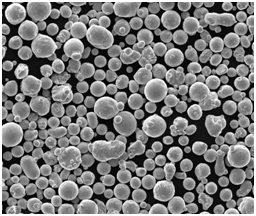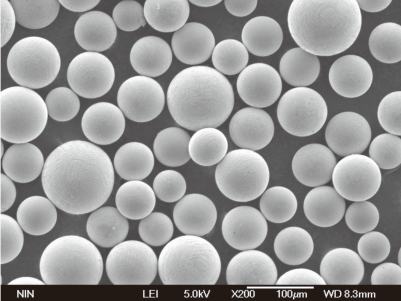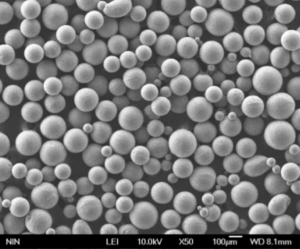Bienvenido al mundo de Sistema de impresión 3D EB¡! Si está buceando en este ámbito, probablemente esté buscando entender qué hace que la impresión EB 3D funcione, cómo se compara con otras tecnologías y qué materiales específicos son los más adecuados para sus proyectos. Vamos a explorar esta fascinante tecnología en profundidad, cubriendo todo, desde sus fundamentos hasta los detalles más minuciosos de los polvos metálicos, y por qué podría ser el cambio de juego que está buscando.
Visión general del sistema de impresión 3D EB
La impresión 3D por haz de electrones (EB), también conocida como fusión por haz de electrones (EBM), es un proceso avanzado de fabricación aditiva que utiliza un haz de electrones de alta energía para fundir y fusionar polvos metálicos capa a capa, creando geometrías complejas con gran precisión y excelentes propiedades de los materiales. A diferencia de los métodos tradicionales, la impresión EB 3D permite crear diseños intrincados que de otro modo serían imposibles o extremadamente costosos de producir.
Detalles clave:
- Tecnología: Fabricación aditiva
- Proceso: FUSIÓN POR HAZ DE ELECTRONES
- Materiales: Principalmente polvos metálicos
- Aplicaciones: Industria aeroespacial, implantes médicos, automoción, herramientas, etc.
- Ventajas: Alta precisión, geometrías complejas, propiedades superiores de los materiales
- Limitaciones: Coste inicial elevado, opciones de material limitadas, requiere un entorno de vacío

Tipos y características de los polvos metálicos para la impresión EB 3D
Elegir el polvo metálico adecuado es crucial para el éxito de la impresión EB 3D. A continuación encontrará una tabla detallada de modelos específicos de polvo metálico, sus composiciones y características clave.
| Modelo de polvo metálico | Composición | Propiedades | Caracteristicas |
|---|---|---|---|
| Ti-6Al-4V | Ti-6Al-4V | Alta resistencia y ligereza | Ampliamente utilizado en implantes aeroespaciales y médicos |
| Inconel 718 | Ni-Cr-Fe | Resistencia a altas temperaturas | Adecuado para álabes de turbina y componentes sometidos a grandes esfuerzos |
| CoCrMo | Co-Cr-Mo | Excelente resistencia al desgaste | Ideal para implantes dentales y ortopédicos |
| Acero inoxidable 316L | Fe-Cr-Ni-Mo | Resistente a la corrosión | Se utiliza en aplicaciones marinas y médicas |
| AlSi10Mg | Al-Si-Mg | Ligero, buenas propiedades térmicas | Popular en las industrias automovilística y aeroespacial |
| Acero martensítico envejecido (1.2709) | Fe-Ni-Mo-Co | Alta resistencia, buena dureza | Se utiliza para utillaje y piezas de alto rendimiento |
| Cobre (Cu) | Cobre puro | Excelente conductividad térmica y eléctrica | Aplicaciones en electrónica e intercambiadores de calor |
| Niobio (Nb) | Niobio puro | Alto punto de fusión, buena ductilidad | Se utiliza en superconductores y componentes aeroespaciales |
| Tántalo (Ta) | Tántalo puro | Resistente a la corrosión, alto punto de fusión | Adecuado para equipos de procesamiento químico |
| Hastelloy X | Ni-Cr-Fe-Mo | Resistente a la oxidación, alta resistencia | Ideal para motores de turbina de gas y hornos industriales |
Aplicaciones de Sistema de impresión 3D EB
Las capacidades únicas de la impresión EB 3D la hacen idónea para una gran variedad de aplicaciones de alto rendimiento. Veamos algunos de los principales usos de esta tecnología.
| Solicitud | Industria | Caso práctico |
|---|---|---|
| Componentes aeroespaciales | Aeroespacial | Palas de turbina, componentes estructurales |
| Implantes médicos | Médico | Implantes de cadera y rodilla, prótesis dentales |
| Piezas de automóviles | Automotor | Componentes de motor, estructuras ligeras |
| Herramientas y moldes | Fabricación | Moldes de inyección, herramientas de fundición a presión |
| Intercambiadores de calor | Electrónica | Soluciones de refrigeración eficientes |
| Materiales superconductores | Energía | Imanes superconductores y componentes |
| Equipos de procesamiento químico | Industrial | Componentes resistentes a la corrosión |
Especificaciones, tamaños, calidades, normas
Comprender las especificaciones, tamaños, grados y normas de los polvos metálicos es esencial para garantizar la compatibilidad y el rendimiento en la impresión 3D EB.
| Polvo metálico | Gama de tamaños de partículas | Grado | Normas |
|---|---|---|---|
| Ti-6Al-4V | 15-45 µm | 5º curso | ASTM F2924 |
| Inconel 718 | 15-53 µm | AMS 5662 | ASTM B637 |
| CoCrMo | 10-45 µm | ASTM F75 | ASTM F1537 |
| Acero inoxidable 316L | 15-45 µm | 316L | ASTM A276 |
| AlSi10Mg | 20-63 µm | DIN 3.2381 | ISO 3522 |
| Acero martensítico envejecido (1.2709) | 15-45 µm | 1.2709 | AMS 6520 |
| Cobre (Cu) | 10-45 µm | Cu-ETP | ASTM B170 |
| Niobio (Nb) | 20-60 µm | R04200 | ASTM B392 |
| Tántalo (Ta) | 15-45 µm | R05200 | ASTM B365 |
| Hastelloy X | 15-53 µm | UNS N06002 | ASTM B572 |






Proveedores y precios
Encontrar el proveedor adecuado es fundamental para mantener la calidad y consistencia de sus materiales de impresión EB 3D. Aquí encontrará una lista de proveedores reputados junto con sus precios.
| Proveedor | Polvo metálico | Precio (por kg) | Sitio web |
|---|---|---|---|
| Polvos avanzados | Ti-6Al-4V, Inconel 718 | $300 – $500 | advancedpowders.com |
| Materiales Sandvik | Acero inoxidable 316L, AlSi10Mg | $200 – $400 | inicio.sandvik |
| Tecnología Carpenter | CoCrMo, acero martensítico envejecido | $350 – $600 | cartech.com |
| Aditivos GKN | Cobre, niobio | $150 – $350 | gknadditive.com |
| Tecnología LPW | Tántalo, Hastelloy X | $400 – $700 | lpwtechnology.com |
Comparación de los pros y los contras de la impresión EB 3D
Es importante sopesar las ventajas y limitaciones de la impresión EB 3D frente a otras tecnologías de fabricación aditiva. He aquí una comparación detallada.
| Aspecto | Impresión EB 3D | En comparación con otros métodos |
|---|---|---|
| Precisión | Alta | Similar a SLM, mejor que FDM |
| Propiedades de los materiales | Superior | Mejor que la mayoría de las técnicas AM |
| Velocidad | Moderado | Más rápido que SLS, más lento que DMLS |
| Coste inicial | Alta | Superior a SLM y FDM |
| Coste operativo | Moderado | Similar a SLM, inferior a DMLS |
| Complejidad de los diseños | Muy alta | Superior a FDM, comparable a SLM |
| Elección de materiales | Limitado | Más restringido que SLM y DMLS |
| Tratamiento posterior | Mínimo | Menos que SLS, similar a DMLS |
| Requisitos de vacío | Sí | Exclusivo de EB, no necesario en SLM/FDM |
Composición del sistema de impresión 3D EB
La composición del sistema de impresión 3D EB incluye varios componentes clave, cada uno de los cuales desempeña un papel vital en el proceso.
- Pistola de haz de electrones: Genera el haz de electrones para fundir el polvo metálico.
- Cámara de vacío: Mantiene un entorno controlado libre de contaminantes.
- Dispensador de polvo: Garantiza una distribución uniforme del polvo metálico.
- Plataforma de construcción: Soporta la pieza que se está imprimiendo y se mueve a medida que se añaden capas.
- Sistema de control: Gestiona todo el proceso de impresión, desde el control del haz hasta la distribución del polvo.
Características del sistema de impresión 3D EB
Comprender las características únicas de la impresión EB 3D es esencial para aprovechar todo su potencial.
- Alta densidad energética: El haz de electrones puede fundir con precisión metales de alto punto de fusión.
- Entorno de vacío: Esencial para prevenir la oxidación y garantizar la integridad del material.
- Fusión por capas: Permite crear geometrías complejas con todo lujo de detalles.
- Estrés térmico mínimo: Reduce el alabeo y las tensiones residuales en las piezas impresas.
Ventajas del sistema de impresión 3D EB
¿Por qué debería plantearse la impresión EB 3D? He aquí algunas razones de peso:
- Propiedades materiales superiores: Consigue excelentes propiedades mecánicas y homogeneidad del material.
- Geometrías complejas: Capaz de producir diseños intrincados y estructuras internas.
- Reducción de residuos: Utiliza sólo la cantidad necesaria de material, minimizando los residuos.
- Menos postprocesamiento: Normalmente requiere menos trabajo de acabado en comparación con otros métodos.
Limitaciones de Sistema de impresión 3D EB
Ninguna tecnología está exenta de inconvenientes. He aquí algunas limitaciones a tener en cuenta:
- Coste inicial elevado: Los costes de equipamiento e instalación pueden ser prohibitivos para las pequeñas empresas.
- Limitaciones materiales: Menos opciones de materiales en comparación con otros métodos de AM.
- Requisitos de vacío: La necesidad de un entorno de vacío puede complicar la instalación.
- Velocidad: Más lenta que otros métodos de impresión 3D, sobre todo para piezas grandes.

preguntas frecuentes
| Pregunta | Respuesta |
|---|---|
| ¿Qué es la impresión EB 3D? | Un proceso de fabricación aditiva de alta energía que utiliza haces de electrones para fundir polvos metálicos capa por capa. |
| ¿Qué industrias utilizan la impresión EB 3D? | Principalmente industrias aeroespacial, médica, automovilística y manufacturera. |
| ¿Qué materiales pueden utilizarse? | Principalmente polvos metálicos como Ti-6Al-4V, Inconel 718 y acero inoxidable 316L. |
| ¿Cómo se compara con el SLM? | Ofrece propiedades de material y precisión superiores, pero tiene menos opciones de material. |
| ¿Cuáles son las principales ventajas? | Alta precisión, excelentes propiedades de los materiales y capacidad para crear geometrías complejas. |
| ¿Cuáles son las principales limitaciones? | Coste inicial elevado, materiales limitados y necesidad de vacío. |
| ¿Es necesario el tratamiento posterior? | Típicamente mínimo comparado con otros métodos como SLS y DMLS. |
| ¿Cuáles son las aplicaciones más comunes? | Álabes de turbina, implantes médicos, componentes de motores y utillaje. |
| ¿Cómo se genera el haz de electrones? | Utilización de un cañón de electrones en una cámara de vacío. |
| ¿Cuál es el coste típico de los polvos metálicos? | Los precios oscilan entre $150 y $700 por kg, según el material. |
Conclusión
El sistema de impresión 3D EB destaca en el panorama de la fabricación aditiva por su capacidad para producir piezas metálicas complejas de alta calidad con precisión y excelentes propiedades de los materiales. Aunque conlleva costes más elevados y algunas limitaciones de material, las ventajas que ofrece en cuanto a reducción de residuos, mínimo postprocesamiento y propiedades mecánicas superiores lo convierten en una opción atractiva para sectores en los que el rendimiento y la calidad son primordiales. Tanto si trabaja en el sector aeroespacial como en el médico o en cualquier otro campo de alta tecnología, comprender los matices de la impresión EB 3D puede ayudarle a tomar decisiones informadas sobre sus procesos de fabricación.

